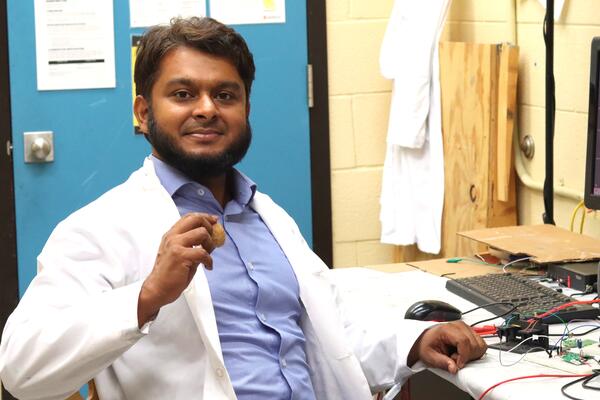
Using the moon's soil to support life, energy generation and construction
Waterloo researchers figure out how to process raw materials on the moon to power lunar development and one day make it a viable home for humans

Waterloo researchers figure out how to process raw materials on the moon to power lunar development and one day make it a viable home for humans
By Media RelationsImagine the moon as a hub of manufacturing, construction and even human life. It's no longer a far-fetched idea baked in science fiction lore — increased interest and investment in space exploration are pushing efforts to develop the technologies needed to make the moon a viable home for humans.
Developing lunar infrastructure requires building materials, and shuttling these over from Earth would be costly and inefficient. This has fuelled research into the in-situ processing and use of raw materials naturally found on the moon's surface. However, one major challenge with this approach will be the immense amount of power the lunar resource processing will need.

Combustion chamber designed to simulate the lunar environment.
A research team from the University of Waterloo's Laboratory for Emerging Energy Research (LEER) is looking into processing lunar regolith, the moon's top layer of soil and dust, into usable materials for life support, energy generation and construction. This includes investigating the use of defunct satellite material as a fuel source when mixed with lunar regolith.
"Lunar regolith contains lots of metallic dust embedded with oxygen," said Connor MacRobbie, a PhD candidate supervised by professors Dr. John Wen and Dr. Jean-Pierre Hickey in Waterloo's Department of Mechanical and Mechatronics Engineering.
"Because it already contains oxygen, we can utilize it, without the need for atmospheric oxygen, to produce thermal energy," MacRobbie said. "This is called a thermite reaction, which is useful in space because there is no readily available oxygen."
The LEER team conducted experiments using simulant "lunar" regolith synthesized and supplied by the National Aeronautics and Space Administration agency (NASA). Tests were performed at different fuel and oxidizer compositions and with varying particle sizes to control the energy release rate of a space-based thermite for either heating or manufacturing.

Lunar regolith - the moon's top layer of soil
"The results demonstrate the viability of the moon's topsoil to power lunar development, enabling humans to explore and inhabit the moon's surface," said Wen, the director of LEER.
"We're now continuously working at better extraction of metal and other useful material from the regolith as well as designing automated processes, in collaborations with Canadian and international researchers, to facilitate in-situ resource utilization and support the circular space economy."
A potential threat to humanity's future in space is the millions of bits of fast-moving debris that travel Earth and the moon's orbits. The European Space Agency (ESA) equates a collision with a one-centimetre particle of space debris travelling at 10km/s to that of a small car crashing at 40 km/h.
The LEER research team is working to address this problem by recycling defunct satellite material into a fuel source for space development.

The LEER team (L-R): Navid Assi, Dr. John Wen, Dr. Anqi Wang, and Connor MacRobbie
"Defunct satellites have enormous potential value," said MacRobbie. "They're made up of many useful materials, including aluminum, which, when added to lunar regolith, can produce a thermite reaction and generate heat."
Using the thermite reaction to repurpose salvaged space debris also provides materials for maintaining and developing solar satellite systems in space, ensuring power for further space exploration.
"Our research is turning science fiction into reality," says MacRobbie. "Our goal is to help build the infrastructure and technology that will allow sustainable human settlement on the moon – and beyond."
More information about this work can be found in the recent research papers Leveraging the use of Novel Lunar ISRU and ISRP Processes with Space Based Solar Power and In-situ Regolith based Nanothermite Heating for Lunar Rovers and Equipment during the Lunar Night, both published by the International Astronautical Federation.

Read more
New Canada Research Chairs will tackle future-focused problems from social robots and intergroup attitudes to geochemistry and nanoscale devices

Read more
Twenty-six researchers receive federal funding to drive discovery, innovation and research infrastructure development

University of Waterloo Engineering PhD candidate Nazmul Hossain helped devise a device that can generate a small amount of electricity using waste walnut shells and a few drops of water. (University of Waterloo)
Read more
Waterloo researchers power a calculator with discarded walnut shells and drops of water
The University of Waterloo acknowledges that much of our work takes place on the traditional territory of the Neutral, Anishinaabeg, and Haudenosaunee peoples. Our main campus is situated on the Haldimand Tract, the land granted to the Six Nations that includes six miles on each side of the Grand River. Our active work toward reconciliation takes place across our campuses through research, learning, teaching, and community building, and is co-ordinated within the Office of Indigenous Relations.